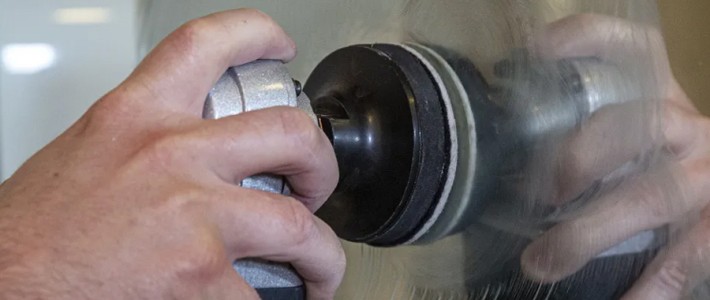REMOVING HAZINESS FROM GLASS

Removing haziness from glass through polishing can restore its clarity and enhance its aesthetic appeal.
One effective method involves using cerium oxide paste, a versatile compound renowned for its micro abrasive properties and ability to polish away imperfections. By employing cerium oxide paste for glass polishing, you can effectively eliminate haziness and rejuvenate the appearance of glass surfaces, leaving them sparkling and shinning.
If you have removed scratches from the glass using an abrasive and have been left with a hard to remove haziness, then please follow these steps in helping to restore the clarity back into your glass.
The first thing to make sure is that you have used the GlasX™ 60 - Fine Grade Abrasive (blue) enough. The more time spent with this abrasive the easier it will be to polish the haziness away.
Apply the cerium oxide paste onto the felt polishing pad and apply it to the area of the glass surface you have been working on, using gentle yet firm pressure start spreading the polish on the hazy area. You must make sure you have a constant slurry on the glass and once the polish has dried up on the glass you can apply water onto the pad. You must make sure that there is not a build up of polish on the felt polishing pad as this will not polish the glass and could cause marks to be left.If this is the case you are applying too much polish on the pad and will have to scuff the pad up and apply water which will reactivate the compound already on the pad.
Always start on a small area each time which will help polish the glass. Please be careful with the temperature of the glass especially working with float or laminated glass, again using water to cool the glass down each time. You do need some heat in the glass to help you polish but not too hot that you cannot touch the glass. Continue polishing until the desired clarity is achieved, periodically wiping away excess paste with a clean cloth. Finally, rinse the glass thoroughly to remove any remaining residue.
If you still cannot polish the glass to the required effect, you may need to revert back to using the blue GlasX 60 abrasive.

2 Comment(s)
How much water is he right amount to use and is it best to spray water directly onto the pad or the glass?
Hello David, Thank you for leaving a comment on our Blog.
We use water in our process for two reasons, one to cool the glass down and secondly to reactivate the cerium oxide when on the final polishing stage.
When cooling the glass down you can spray the glass multiple times, you will find if the glass is very hot the water will instantly evaporate and you can apply more. When the evaporation slows down you then know you can begin working again.
When polishing at the end stage the glass can get hotter quicker but you do not want to spray to much water as this will dilute the cerium oxide on the glass and make any polish left run down the glass and disappear. You need to have a constant mixture of water and polish at the same time, too much water and you will not be able to get grip and polish any haziness from the glass.
Leave a Comment, tell us if you found the post helpful or let us know if you need any further support.